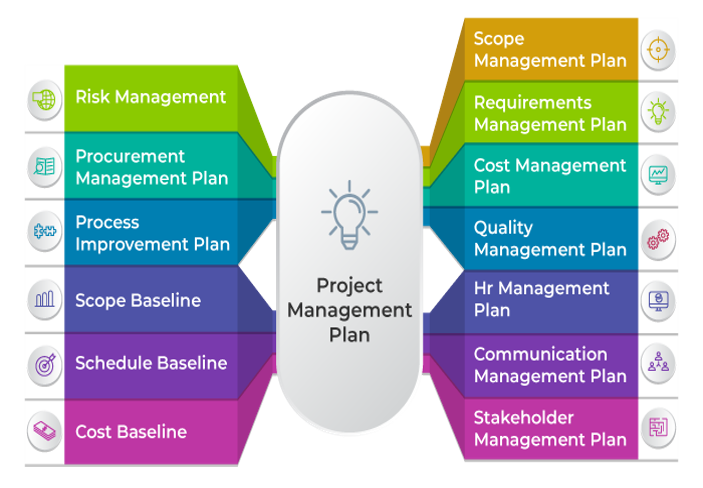
Without a proper Project Management plan in place, the clients will be exposed to chaotic management, facing unclear objectives, lacking proper resources, and depending on unrealistic planning which involves high risks that yield poor quality deliverables that are derived from high expenditures.
What is a Project Management Plan?
It is a document formally approved and which is used to manage project execution. The Project Management plan documents the actions required to define, prepare, integrate and coordinate the various planning activities. The PMP clearly defines how the project is executed, monitored and controlled, and closed.
The main criteria of such a document are to provide a comprehensive framework of what has to be achieved through the execution of the project, procedures to solve it, steps to measure and report the project, and also as to how the information will be communicated, and importantly who will be involved in it. The PMP should be used as a reference for any decision that is made on the project and for clarification of unclear areas.
| Enroll in our PMP Certification Training today, and develop a strong foundation in the principles of Project Management. |
Inputs of Project Management Plan
The inputs of the Project Management Plan will roughly cover the concept of a project charter, project scope, enterprise environmental factors, etc. The main objective aligns with the feasibility and project scope to determine the efficacy of the potential project.
Project Charter
It’s the process of setting out detailed project goals, roles, and responsibilities, identifying the primary stakeholders, and the level of authority of a project manager.
Outputs from Other Planning Processes
Other planning processes include outputs from all subsidiary plans that encompass the details of various factors involved in the formal management plan. (Eg. Scope Management, Cost Management, HR Management, Quality Management).
Enterprise Environmental Factors
Internal and external factors will be a familiar aspect while developing a Project Charter and in the case of producing a Project Management Plan.
| Internal Factors | External Factors |
|---|---|
| Organizational Structure | Government Regulations |
| Organization’s Culture | Market Conditions |
| Working Style | Political Situations |
| Organization Policies | Weather Conditions |
| Reviews And Training Records | Infrastructure |
Organization Process Assets
As mentioned earlier in the project charter section, OPA will look into policies, procedures, financial database, project management database, previous project databases, etc.
| Knowledge Base | Procedure/ Processes/ Policies |
|---|---|
| Lessons Learned | Project Lifestyle |
| Project Files | Organization Process Documents |
| Financial Database | Communication Management |
| Project Management Database | Guidelines |
| Previous Projects Database | Policies |
Tools and Techniques
The tools and techniques ensure an efficient way to deal with the project by bringing out the best and most optimum solution to complete the project in time.
Expert Judgment
To bring out a precise and tailored process that meets the project’s needs, the project manager will analyze technical and management information to implement them into the plan.
Data Gathering
- Brainstorming – The brainstorming technique is used for developing the project management plan to gather ideas and solutions as to how the project is to be approached. Participants include the project team members, subject matter experts (SMEs), and stakeholders.
- Checklists – Most organizations have standard checklists readily available based on their experience or use checklists from the existing industry. A checklist will help the project manager to develop a plan and also to verify whether all the required information is included in the project management plan.
- Focus Groups – The focus group technique brings together the project stakeholders to discuss the project management approach and the integration of the different components of the project management plan.
- Interviews – The interview technique is used to obtain relevant information from stakeholders to develop the Project Management or component plan or project document.
Interpersonal and Team Skills
- Conflict Management – The main benefit of the conflict management technique is that it’s used to bring diverse stakeholders into a collective agreement or decision based on all the aspects of the project management plan.
- Facilitation – Effective participation is the key to the success of a project, and this facilitation technique will enable and ensure that all the individuals associated with the project are on the same page. The project manager, the team members, and the stakeholders should have a mutual understanding and contribute equally towards the success of the project.
- Meeting Management – This meeting management technique is necessary to ensure that the project is progressing according to the Project Management Plan and that the concerned reports are submitted and verified by the stakeholders and other higher authorities associated with the project.
Meetings
These Meetings are mostly used to discuss the project approach, determine how the project work will be carried out to accomplish the project objectives and establish a way to monitor and control the project. Usually, project managers conduct a project kick-off meeting at the end of the project planning and before the start of project execution. Its meeting will communicate the project objectives, and the team commitments, and explain the roles and responsibilities of the stakeholders.
Project Management Plan – Output
- Project Management Plan: Eventually, Project Management Plan is the final output that will be derived from the developed Project Management process. The plan will also teach all subsidiary plans of the project.
To further extend some insights on the outputs of the Project Management Plan, below mentioned outcomes are to be noted. - Scope Baseline: It is a baseline that judges the performance of the Project Manager and the rest of the team during a project. It includes aspects of the project scope statement, the Work breakdown structure (WBS), and the WBS dictionary.
- Schedule Baseline: The schedule baseline is the approved version of a schedule model that can be altered only through formal change control procedures, and the schedule baseline is used as a basis for comparison to actual results.
- Cost Baseline: It’s the authorized time-phased expenditure plan for the project on which the project cost performance is to be measured.
- Scope Management Plan: The Scope Management Plan refers to the set of processes that ensure a project’s scope is accurately defined and mapped. The techniques will enable the project managers and supervisors to allocate the right amount of work primarily controlling what part of the project has an essential scope.
- Requirements Management Plan: The method used in documenting the necessary information required to efficiently manage project requirements from the definition, through traceability, to delivery.
- Cost Management Plan: It’s considered one of the primary functions of the Project manager. It functions as a significant component of the entire life-cycle of a project, as it defines the success and progress of any project.
- Quality Management Plan: A feature that explains the approval level of quality, which is primarily defined by the customer, and showcases how the project will ensure this level of quality in its deliverables and work processes.
- HR Management Plan: Human Resource management is a tool that will assist in the monitoring of a project’s human resource activities throughout the project until closure. It also decides the roles and responsibilities of team members throughout the project.
- Communication Management Plan: This method plays a crucial role as it acts as a mode of communication across all the levels of a project and also addresses all stakeholders involved with the project.
- Stakeholder Management Plan: The process of developing precise management strategies to effectively engage stakeholders throughout the life-cycle of the project, based on the analysis of their needs, interests, and potential impact on project success.
- Risk Management Plan: It is a document that a project manager prepares to foresee risks, estimate impacts, and define responses to issues.
- Procurement Management Plan: The process of documenting project procurement decisions, specifying the approach, and identifying potential sellers. This process determines whether to acquire support externally, and if so, what is to be obtained, how is it to be received, how much of it is needed, and when is to be gained.
- Process Improvement Plan: This tool is a subsidiary plan of the Project Management plan. This process instead of only concentrating on single issues will encourage the team to examine how different circumstances are affecting the current conditions in a project.
Steps to Create a Successful Project Management Plan
Step 1: Know the Scope and Value of Your Project
A project strategy describes the methodology at heart, and the mechanism the team may use to execute the project by scale. A business strategy provides essential knowledge to all partners participating in the business. If you handle it as more extensive than just a dry text and express the part of it to all involved accordingly, it will and will be seen as crucial to the progress of the project. The truth is, there are more than dates to a calendar. It is your project’s story, and you don’t want it to be a long one! There are components like any well-written story which make it pleasant. Any concrete proposal should directly answer those questions:
- What are the excellent outcomes?
- How are we working on getting to those deliverables and the time limit?
- Who is on the development team, and what part are they going to play in those outcomes?
- When is the team going to reach goals and when are other team members going to play a role in contributing to or getting input on those results?
Step 2: Get to Know Your Stakeholders
Get read about the chaotic realities of corporate dynamics, conflicting attitudes, and potential conversation points that can affect the project management process. All concerned want the project to thrive, but failing to satisfy only one influential stakeholder’s needs could spoil it for everyone.
Take a minute to:
- Make it more apparent who the people participating in the project are
- Know their aspirations and their level of impact
- Decide how you can integrate peer and stakeholder reviews as the project progresses
- Relate all criteria and standards for risk preparation and risk response activities
- Conscientiously prepare the communication methods of a project
Step 3: Conducting the Kick-off Meeting
It is an important way of getting together key partners to address the proposal. The preparation process begins with a kick-off meeting. It’s also helpful in building morale in all team members. During kick-off sessions, all participants’ thoughts need to be taken into account. It often reflects the contribution of the investor to the initiative. Shaping a meeting’s agenda includes:
- Project idea (sponsor)
- Business vision / strategy (sponsor)
- Team outlook
- Delegation of roles and responsibilities
- Decision-making processes
- Team Responsibilities
- Size of team and sub-teams
- Ground rules
Kick-off meetings should take place in such a manner that everyone becomes conscious of the outcomes they expect from them. It should also assure that in leading to completion, the project receives the requisite purchase.
Step 4: Think Through Goals and Scope
Build a topic answer that lays down just what you’re working to remedy, in exact words. Then create a theory that specifies what you believe the outcome of your project should be. Second, draw out a brief description of the project and any evidence or observations to support it. And define the measures you will be used to assess performance – these will presumably inform different areas of your system.
Tell yourself and the members of your team what you have vs what would like to have or maybe even what is not necessary. By deciding on the design of the project at an initial point and what is not in nature – you minimize the possibility of misunderstanding with the partners. You know how much time to give the other people who assist with the project. And you’ll quickly notice shifts in nature.
The scope is a total predator. The trick is to manage scale, schedule, and capital so that both do not get out of hand.
Step 5: Write your Complete Project Plan
You can be more than relaxed enough to bring together a pretty stable project plan using whatever strategy fits for you because you have all the details you want, and you’ve talked to both stakeholders. (Ahem, TeamGantt works pretty well with a lot of pleased clients). Any successful online project preparation platform can help formalize and map out your ideas in a coherent, concise manner.
Step 6: Share Your Plan with the Team and Make Sure they Read It!
Since you have invested all your effort into making this vital paper, you want to make sure it’s adequately reviewed. When submitting your project proposal, ensure that you have a description of it in prose style. A short note explaining the general process, finances, expectations, timelines, and corresponding approval periods will help you explain what the project schedule means to the team and those concerned.
Please don’t be shy about it: clarify the thinking that went into the project plan construction process, and open it up for conversation. Setting up a call to update the schedule line by line with a client may be superior. This means that the client knows the procedure and what is implied by each step in the strategy. Yeah, you may need to clarify it a couple more times, but at least you’re attempting to help set consistent guidelines around the board for project preparation and teach your customers how your team operates. And it means you care, again.
How to Ensure A Successful Project Plan?
Set Project Objectives
Any project, however small or big, has stakeholders. Stakeholders are those individuals or entities that are directly or indirectly impacted by a project. The project is deemed a success when the stakeholders are happy. Therefore, the first thing to do as a project manager is to identify the project’s stakeholders, which is not an easy task in itself. Stakeholders could be any of the following:
- Project sponsor
- Customer who is paying for the deliverables
- The user who will be using the deliverables
- Third-party vendors
- Project team
Meet with each of these stakeholders individually and list out their expectations. Stakeholders tend to have expectations, which usually might not be beneficial, and wouldn’t even know that. You have to identify the needs which will have a direct benefit to stakeholders.
Once the list of requirements is created, you now have to prioritize them based on a direct impact on the project. Based on the prioritized list of needs, set project objectives, and record them in the project plan. This is the most fundamental and challenging phase of the planning process. Now that you have set project objectives, you have a target to work towards.
List Project Deliverables
Now that you know what the project’s objectives are list down deliverables that will help you achieve those objectives. These deliverables might have dependencies among themselves. Take extra caution to make a note of these dependencies. This will help you set a more accurate schedule for the project. The estimated completion time can be set for each deliverable, but you would be able to do that more precisely in the next step.
Allocate Resources
Break down these deliverables and create a list of tasks that need to be performed to create each of these deliverables. Identify by name, the human resources who would be responsible for the completion of each task and their respective roles and responsibilities. Brainstorm with each team member and come up with an estimated time to complete each of the tasks. The other key thing to do is try and estimate the cost of completing each task. You may not be able to do it accurately at this point in time. However, it is helpful to have an idea of the cost involved to distribute the funds more efficiently.
Set the Project Timeline
Taking into account the dependencies between the tasks that have been listed, set a timeline for the project to be completed.
At this stage, in most cases, you might discover that the project sponsor has imposed an unfair deadline for the project. Now that you have a plan for the project, you need to go back to the project sponsor to re-negotiate the deadline. The following three things can be done.
- Deploy additional resources
- Reduce project scope
- Extend the deadline
This activity can be done right at the beginning instead of the project running behind schedule or overrunning the cost late, which might be of more severe consequences. The project sponsor would have no option and will listen to your recommendation when you justify them with your project schedule.
Risk Management and Communication Plan
An essential phase of project planning is risk management. Projects bring about change. With the change, there comes along a certain amount of risk. A good project manager always forecasts possible risks and prepares for them. You can never be sure which risks would materialize or if new ones would come up as the project progresses. Therefore, it is prudent to forecast the possible dangers, create a risk remediation action plan for each of them, and allocate a specific risk budget to help you implement it. The most common risks that a project could face are:
- Stakeholder needs are not being understood or their inputs are not recorded.
- Stakeholders are adding new requirements during the project.
- Time and cost estimates are set too optimistically.
- Unclear roles and responsibilities of team members.
- External factors – government regulations, natural calamities, etc.
Maintaining a risk log where you can record all the risks, their associated remediation plans, and other information will prove to be very helpful. It will serve as a key source of lessons for future projects too. Communication is another critical piece of your project planning jigsaw. However, efficiently the above four steps had been done. If the project team does not communicate well, there will be chaos, and the project will eventually fail. Decide reporting guidelines – daily, weekly, or monthly progress reports. Agree with the team on a single mode of communication. There might be different team members with different preferences to communicate, especially with the myriad options technology has given us these days. However, it is essential to agree on one mode of communication and ensure that everyone in the team sticks to it. Set a common portal where everyone can keep track of progress, and share their suggestions and opinions.
Conclusion
The Project Management Plan is considered a meta-plan of the project plan. It is the actual plan which is followed by the Project Management team at all levels to accomplish the given project. The PMP is also regarded as crucial as it precisely describes every possible detail in a broader manner. The sole agenda of a plan is to execute and achieve the vision of the undertaken project. Give yourself a chance to enhance your Project Management skills with PMP certification training, and excel in your career.
Know more about Project Management best practices through Invensis Learning’s Project Management certification training on PMP Certification Course, CAPM Certification Exam Prep, Prince2 Certification, Project Management Fundamentals, etc.

















